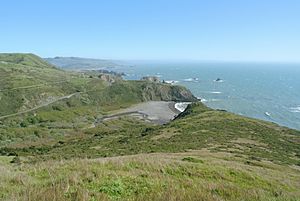California coastal prairie facts for kids
The California coastal prairie is a special type of grassland found along the Pacific Coast. It stretches from Los Angeles in Southern California all the way up into southern Oregon. Think of it as a natural carpet of grasses and other plants that grows near the ocean.
Contents
What is Coastal Prairie?
California's coastal prairies are amazing because they have more different kinds of plants than almost any other grassland in North America. You can find up to 26 different plant species in just one square meter!
Sadly, a lot of this unique habitat has been lost. About a quarter of it has been covered by roads and buildings.
Strong winds, salty ocean spray, natural fires, and animals grazing (eating grass) have always helped keep these grasslands open. They stop shrubs and trees from growing too much and turning the prairie into a forest. If there's no grazing or fire, trees and bushes can start to take over.
Over many years, dead plants and other organic matter build up in the soil. This creates a rich, dark soil called mollisol, which is perfect for grasses. Coastal prairies often grow next to another plant community called Northern coastal scrub. You can also find coastal prairies on flat areas called coastal terraces, which are often used for farming, like in places such as Santa Cruz.
Plants and Animals You Might See
This special grassland is home to many unique plants. Here are some of the common ones:
- Perennial bunch grasses: These are grasses that grow in clumps and come back year after year.
- Other plants:
Rare and Endangered Species
Some of the rarest plants in the coastal prairie actually grow best where livestock like cows or sheep graze. When these animals are removed for conservation, these rare plants can sometimes disappear.
Here are some rare and endangered species found in the coastal prairie:
- Rare Plants
-
- Santa Cruz tarweed - Holocarpha macradenia (found in only a few spots)
- San Francisco popcornflower - Plagiobothrys diffusus
- Robust spineflower - Chorizanthe robusta robusta
- Artist's popcornflower - Plagiobothrys chorisianus
- Pt. Reyes meadowfoam - Limnanthes sp.
- Santa Cruz clover - Trifolium buckwestiorum
- Indian clover - Trifolium amoenum
- Gray's clover - Trifolium grayii
- San Francisco owl's clover - Triphysaria floribunda
- Rare Animals
Threats to the Habitat
Unlike many other grasslands, the coastal prairies stay green all summer. This makes them very appealing for grazing animals like cattle and sheep. However, farming and new buildings have also caused a lot of this habitat to be lost.
Like most California grasslands, coastal prairies have been greatly affected by new species that are not native to the area. These include earthworms, snails, slugs, and certain annual grasses from the Mediterranean region.
Recently, invasive perennial grasses have become a big threat. These include velvet grass (Holcus lanatus), tall fescue (Festuca arundinacea), and Harding grass (Phalaris aquatica). Sometimes, careful grazing by livestock can help reduce these invasive grasses and allow native plants to grow. Other woody plants like gorse and broom also pose a threat by spreading into the prairie.
How Coastal Prairies Are Protected
California's coastal prairies are protected by a law called the California Coastal Act. This law considers these habitats to be Environmentally Sensitive Habitat Areas (ESHA). This means that it's against the law to harm these habitats. The only time harm is allowed is if it's necessary to help restore the habitat, like using controlled fires or allowing grazing to improve the overall health of the prairie.
More About Their Protection
Coastal Prairies in California are considered critically endangered. This means they are at a very high risk of disappearing. The main reasons for this are:
- Invasive species: Plants and animals that don't belong there and take over.
- Low nutrient soils: Some areas have poor soil quality.
- Urbanization: More cities and towns being built.
- Unregulated recreational activities: People using the land without rules, which can damage it.
Plants in this environment also face tough natural challenges. They have to deal with constant sun, a lot of salt from the ocean, strong winds, and damage from sand dunes or even being covered by sand. Strong winds and salt can be very damaging to plants, especially those not used to such harsh conditions. In the past, efforts to stabilize sand actually made it easier for invasive species to grow.


